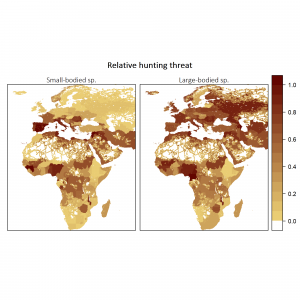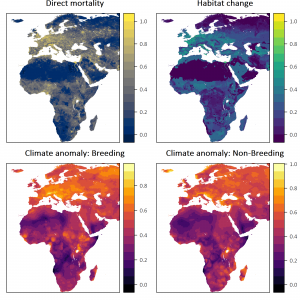Built infrastructure, hunting and climate change are linked to huge migratory bird declines
June 27, 2022
Migratory birds are declining globally because of the way that humans have modified the landscape over recent decades – according to new research from the University of East Anglia, the University of Porto and the University of Lisbon (both Portugal) and the Czech Society for Ornithology (Czech Republic). A new study, which was based also on the PECBMS data, reveals that population declines have been greatest among species that migrate to areas with more human infrastructure - roads, buildings, power lines, wind turbines - and higher population densities and hunting levels. Habitat degradation and climate change have also played a part in driving long-term declines.

The risks mapped onto the globe: the combined risk surface for all threats categorised as ‘direct mortality’ – i.e. roads, nocturnal lights, human population density, hunting, powerlines, windfarms. (It therefore doesn’t include the habitat and climate change risks).
The research team hope their work will help inform how best to target conservation efforts.
Dr James Gilroy, from UEA’s School of Environmental Sciences, said:
“We know that migratory birds are in greater decline than non-migratory species, but it’s not clear why. We wanted to find out where in their life cycles these migratory species are most exposed to human impacts.”
The research team identified 16 human-induced threats to migratory birds, including infrastructure associated with bird disturbance and collisions, conversion of land from natural habitat to human land use, and climate change.
Advances in satellite imagery allowed the team to map each of the 16 threats across Europe, Africa and Western Asia. The team also created the first-ever large-scale map of hunting pressure across the region.

Relative levels of hunting of small- and large-bodied birds across the study region.
A total of 103 species of migrating birds were studied, including many rapidly declining species like the Turtle Dove and the Common Cuckoo, using large-scale datasets.
The team calculated ‘threat scores’ for factors such as habitat loss and climate change across breeding locations and non-breeding ranges.
They then explored the relationships between these threat scores and bird population trends calculated from 1985 to 2018 by the Pan-European Common Bird Monitoring Scheme (PECBMS).
Dr Claire Buchan, from UEA’s School of Biological Sciences, said:
“We found that human modification of the landscape in the birds’ distribution ranges in Europe, Africa and Western Asia is associated with declining numbers of over 100 Afro-Eurasian migratory birds. When we talk about modification of the landscape, we mean things like roads, buildings, powerlines, wind turbines – anything that isn’t naturally there.”
One of the biggest impacts seems to be caused by things that would kill a bird outright – for example, flying into a wind turbine or building, being electrocuted on a powerline, hitting a vehicle or being hunted.
“We found that the long-term declining trends of the migratory species reflect their exposure to human-induced ‘direct mortality’ threats which the birds face in their wintering sites,”
explained Dr Alena Klvaňová, the PECBMS project manager.

Composite maps for the three risk layer groups. Climate anomalies vary seasonally, so we created separate risk surfaces for the breeding and non-breeding seasons. Maps represent the unweighted combination of their constituent layers, i.e. with no species-specific information fed into their creation.
Dr Aldina Franco, also from UEA’s School of Environmental Sciences, added:
“Our findings are important because we need to understand where declining species are being most impacted by humans across their seasonal migrations. Pinpointing where birds are most exposed to these threats could help us target conservation actions.”
This research was led by UEA (UK) in collaboration with the University of Porto and the University of Lisbon (both Portugal) and the Czech Society for Ornithology (Czech Republic).
The research was published in the journal Global Ecology and Biogeography on June 25, 2022.
Buchan, C., Franco, A. M. A., Catry, I., Gamero, A., Klvaňová, A., & Gilroy, J. J. (2022). Spatially explicit risk mapping reveals direct anthropogenic impacts on migratory birds. Global Ecology and Biogeography, 00, 1–19. https://doi.org/10.1111/geb.13551

The Turtle Dove migrates to sub-Saharan Africa and faces a lot of hunting pressure on its annual migration routes, especially in the Mediterranean where hunting is considered part of the cultural tradition. This is also the cause of its significant decline. Since the 1980s, the European breeding population has declined to just 20% of its original size. Photo: Lukáš Kovár (fotokovar.cz)

European populations of the Common Cuckoo are threatened by climate change, which is causing host species to start breeding earlier due to rising spring temperatures, while the Cuckoo, which migrates to sub-Saharan Africa and controls its migration by day length, is not delaying the start of egg laying. Today, about 60% of Cuckoos live in Europe compared to the 1980s. Photo: Lukáš Kovár (fotokovar.cz)

Effects of spatially quantified threats on species population trends: a) Non-breeding direct mortality risk exposure; b) non-breeding climate change risk exposure, with model-predicted slopes for short (10th percentile), mean and long (90th percentile) migration distances; c) Migratory distance; d) Breeding range direct mortality risk exposure, with slopes predicted for low (10th percentile), mean and high (90th percentile) levels of breeding range habitat change. Dashed lines represent associated 95% confidence intervals, and points indicate raw values for each species.
